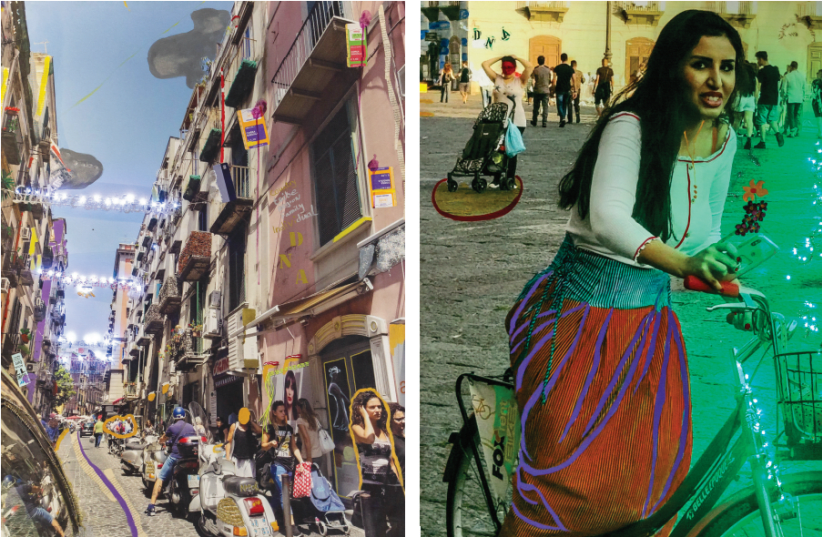Kiryat Hamelacha and Naples, Italy. They may seem worlds apart, yet these southern locales are oddly similar: tailors, ironsmiths, artists and small tradesmen line their narrow streets, set apart from civilization; the stubborn refusal to break from lineage stocks the shelves of every family-owned shop front; while the burning desire to burst out of the neighborhood bubble looms in the stale air.
“They’re small, they’re poor and they’re very, very creative,” Michelle Gavrielov remarks about the two cities. It was these striking connections that drew the Israeli-born artist to Elena Ferrante’s international bestseller, My Brilliant Friend.
The novel, which has had immense success as both a book and an HBO series, follows the fraught friendship of two young girls in their hometown of Naples. It offers a raw, honest gaze into the longing we all share for true friendship, the memories of the neighborhood in which we grew up, and the space these memories take up in our lives as we distance ourselves from our childhoods.
Childhood – and more specifically the misconceived ways in which we perceive ourselves and the world during childhood – forms a strong undercurrent flowing through Gavrielov’s exhibition, My Brilliant Friend from Kiryat Hamelacha, curated by Efi Gen and presently on display at the Municipal Gallery Beit Gordon-London in Rishon Lezion.
Gavrielov grew up in the United States, far removed from her studio in Kiryat Hamelacha. However, her husband’s childhood unfolded right across the street in the Shapira neighborhood. Just south of Tel Aviv, Shapira has offered refuge to immigrants from Turkey, Romania, Senegal and the likes since the mid1940s.
She shares, “The idea to capture these two cities on camera first struck me one day after Purim. I had this nylon bag filled with leftover candy and happened to come across two little girls from Senegal drawing on the sidewalk with chalk. I asked one of the little girls if she needed help and she replied, ‘I’m trying to draw the sun. Everyone tells me the sun has all of these lines, but I just see a faded, blinky thing.’” Gavrielov taught the girl to draw what she saw, rather than focusing on what other people had told her to see. Following this telling exchange, the nomadic artist traveled to Naples to try to capture this same childlike perspective with a camera.
UPON ARRIVAL, she focused her lens on a handful of city dwellers obstinately going about their roles in the community; she met the pizzeria owner, keeping freshly baked dough in the family since 1720; she visited the bakery down the block, where the same family had been whipping up croissants by the baker’s dozen since 1655; she passed the painting school that had been teaching the Renaissance-style since the Renaissance era.
Pleased with her cast of archetypal characters, Gavrielov was still missing her main act: the “Napoletana Girl” depicted in Ferrante’s book.
After much soul-searching, she found her muse in a young Italian girl riding a bicycle down the road.
After shooting twenty-some-odd photos of her “Napoletana Girl,” she returned to her studio in Israel to transfer the photographs to canvas and layer them with LED lights, embroidery, graffiti and other mediums to stress the unexpected details.
The result is one of the exhibition’s highlights, titled The Green Girl.
The second main theme of My Brilliant Friend in Kiryat Hamelacha was discovered on the pavement, also on that post-Purim day. After revealing to the two young girls that her husband, Israeli singer-songwriter Miki Gavrielov, grew up in that very neighborhood with seven or eight siblings, the girls were in awe. Their shock at his ability to make something of himself from so little represented the shared struggle to reach past the confines of these tiny, concealing towns – something that Israelis, Neapolitans, and over 20 million readers can relate to.
Gavrielov reflects, “What surprised me most about opening night [May 4] was not how many people came out in spite of the rockets.
The biggest surprise to me was how many people related to the artwork without having read the book. The exhibition is relatable because the content is relatable, so everyone was able to craft their own stories. Anyone who hasn’t yet, should come and craft their stories, too.
“I feel no nostalgia for our childhood. Every sort of thing happened, at home and outside, every day, but I don’t recall having ever thought that the life we had there was particularly bad.”
– Elena Ferrante, excerpt from My Brilliant Friend.
My Brilliant Friend from Kiryat Hamelacha is on display at the Municipal Gallery Beit Gordon-London in Rishon Lezion until July 18. For more information: Iditanat.com
